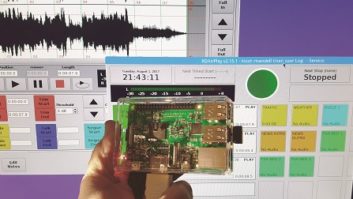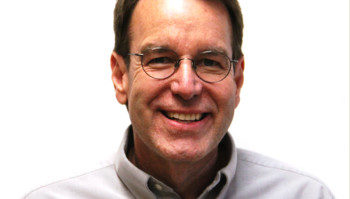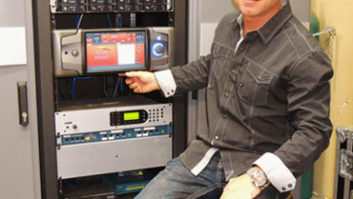The FCC is in the process of revamping its website. The top of its homepage at www.fcc.gov features a banner announcing “a new FCC.gov.” Click on that banner and you get transported to the beta version of the new website.
I took that trip recently. Here are my initial observations.
The color? It’s blue. Very blue. That’s not bad, mind you. Our law firm overhauled its website last year. We went with blue, too. I’m willing to assume that the FCC liked our look.

The feel of the new site? Streamlined, sleek, definitely designed to create an impression without providing a lot of detail.
The utility of the changes, from the perspective of a broadcast-related professional looking for matters of interest and/or use to broadcasters? None.
‘Get involved’
As redesigned, the FCC’s website seems directed to the unknowing-but-curious web-surfer who accidentally happens by, or perhaps the earnest “consumer” who has heard vaguely of the FCC but has no real idea of what it does.
Much like a high school club soliciting participation, the new homepage alone provides three separate buttons inviting visitors to “Take Action” or “Discuss” or “Get Involved.”
The redesigned site definitely is not directed at the broadcast licensee (or its lawyer) who has specific business, or maybe a specific question, relating to some actual FCC rule, policy or action. The redesign relegates the more prosaic aspects of the FCC’s business to the back room, largely out of sight of the occasional passerby.
As a practical matter, certain nitty-gritty elements of the site don’t appear to have changed at all: CDBS, ECFS, ULS, ASR, Daily Digest — all systems that most, if not all, broadcasters use regularly — are still there, looking and working as they have looked and worked in the past.
If you have those pages bookmarked, you needn’t worry about the redesigned aspects of the FCC’s website. (Note, though, that the commission is in the process of overhauling its online licensing systems to consolidate CDBS and ULS into a single all-encompassing licensing portal. Those changes, still in the planning stage, probably won’t be ready for beta testing for a year or more.)
Even if you haven’t bookmarked the old online filing pages, you can get to them from the redesigned front page. From the “Business & Legal” link — one of four menu selections at the top of the page — select “online filing” from the drop-down, and scroll through the online filing options. For the Daily Digest, click on the “Business & Legal” itself and scroll down the list.
I understand that the commission’s “New Media Team,” which is spearheading the redesign, may be planning to retool the back-end pages that haven’t been touched so far in the process. In other words, the FCC’s website is still a work in progress.
Even so, a couple of things seem clear from the changes that have been implemented so far.
Missing on page 1
First, the importance of broadcasting in the overall range of FCC regulatory responsibilities has shrunk. I could find no reference at all to broadcasting rules, regulations or policies on the front page.
That page does include a “Features” section providing links to video presentations by various FCC representatives. One of the six “Features” choices is labeled “Media & Marketplace,” which suggests that it might involve broadcasting (since broadcasting falls within the jurisdiction of the Media Bureau).
But when I clicked on that option, I found myself watching a video by the chairman about “The Broadband Economy: A New Land of Opportunity.” Next to the video were a number of links to “Related Information” and “Related Guides and Help” — none of which referenced broadcasting (except for the link to the commission’s proposal to repurpose TV spectrum for broadband use, not exactly a broadcast-friendly topic).
If you click on the “What We Do” link, part of a drop-down menu that appears when you click on the “The FCC” menu selection at the top of the page, you’ll find nary a word about broadcasting.
In fact, the word “broadcasting” isn’t even included in the new “FCC Encyclopedia.” By contrast, the “B” listings include “Broadband Acceleration” and “Body Tissue Dielectric Parameters.” Presumably the encyclopedia is still being developed; but wouldn’t you think “broadcasting” would have been included from the get-go?
I was able to get to a page that describes the Media Bureau’s activities … in fewer than 40 words. That page provides no links to the Audio or Video Divisions.
The overwhelming impression is that broadcasting is of extremely limited importance on the redesigned site and, possibly, to the FCC itself.
Chip in here
What is important? Blogs by FCC personnel, apparently. And comments from the public. There appears to be heavy emphasis on providing plenty of opportunity for everybody to chip in his/her two cents’ worth.
But that raises a question. While many of the views expressed in the blog and comment sections may be interesting, how exactly do they contribute to the FCC’s functioning?
Perhaps FCC officials may, in their blogs, explain or interpret rules and policies in a way that was lacking in the official announcement of those rules and policies — but if that’s the case, wouldn’t it be more desirable (and legally more reliable) to devote more time to getting those official announcements correct and user-friendly in the first place?
And as far as comments and observations from the public are concerned, what purpose do — or can — they serve? FCC policy, after all, is not determined by a majority vote of some portion of the public, like “American Idol.” Rather, the commissioners are expected to assess the various factual, legal and political arguments and resolve them as a majority of the commissioners see best.
Encouraging public participation in FCC proceedings is not in and of itself a bad idea. But such participation can be counterproductive if it serves only to add noise or static or clutter without helpful substantive contributions. And the potential for such noise/static/clutter has increased by orders of magnitude as a result of Internet-based commenting.
As we have often seen — in, say, the indecency context — the Internet makes it easy to generate hundreds of thousands of submissions overnight. Is each of those submissions deserving of analysis and consideration? I’m guessing not. But if they make it in the door, somebody’s still got to read them, if only to determine that they can be ignored.
And if they all do warrant attention, how can the FCC’s staff be expected to find the time necessary for such analysis and consideration? And if the commission does not have the resources to devote such analysis and consideration, why encourage the public to submit comments that can’t be fully considered?
One final observation about the redesigned website. Change is unsettling because it disrupts our established ways. I polled my law firm colleagues about the FCC’s site, and the vast majority of responses could be summed up as “if it ain’t broke, don’t fix it.”
The old FCC website has plenty of quirks and clunkiness and less-than-user-friendly attributes. But we got used to it. It’s kind of like that funky old hardware store that’s been around since your grandfather’s time. You’ve gone there for years and you know where to look among the crowded aisles for the snow shovels or weed killer or light bulbs, even if there are no directional signs or apparent organization to the way things are laid out.
The FCC’s new design may be an effort to instill a fundamentally different organization in the system. That might be helpful. Let’s not ignore that.
But the new design might also be one more indication of the increasing marginalization of broadcasting in the FCC’s eyes. Regrettably, the beta test version does nothing to discourage such thinking.
Harry Cole is a member of the law firm of Fletcher, Heald & Hildreth, and a long-time contributor to Radio World.









